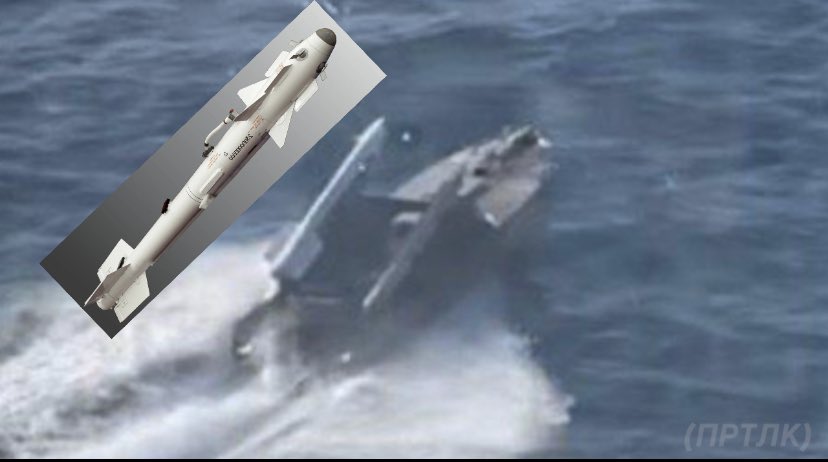Ukraine has armed its explosive drone boats with missiles, marking a significant development in maritime warfare tactics.
The revelation came to light through videos released by the Russian Ministry of Defense, illustrating a dramatic encounter between Ukrainian unmanned surface vessels (USVs) and Russian naval assets.
The footage depicted a Russian Navy Ka-29 attack helicopter circling above a Ukrainian unmanned surface vehicle equipped with an infrared-guided R-73 (AA-11 Archer) short-range air-to-air missile.
Despite evasive maneuvers by the Ukrainian USV, it was ultimately destroyed by gunfire from the helicopter. Detailed analysis of the footage revealed a single R-73 missile mounted on one of two angled rails at the rear of the drone boat.
The Russian account alleged that the other missile was previously launched in an unsuccessful attempt to down a Russian Mi-8 Hip helicopter. One more video showcased the engagement between the boat and helicopter, albeit from a distance, likely filmed from another vessel or warship.
Footage from Russian Ka-29 helicopter engaging Ukrainian USV with R-73 air-to-air heat-seeking missiles. https://t.co/ONS0uacMKB pic.twitter.com/E6zGjmCbuv
— Clash Report (@clashreport) May 6, 2024
The Russian Fighter Bomber Telegram channel expressed astonishment, noting that the Ukrainians managed to link the rocket with the USV’s remote control systems.
The Telegram channel also noted that air-to-air missiles could be employed without radar or separate targeting systems. Instead, the seeker heads detect and lock onto an airborne target.
While no instances of USV-launched air-to-air missiles in combat have been confirmed, proponents have argued that such weaponry poses a major threat, particularly to Russian helicopters, which have been considered an effective countermeasure against Ukrainian USVs.
H.I. Sutton, a reputable Open Source Intelligence (OSINT) analyst, noted the efficacy of the concept despite the USV’s destruction.
“Until now, the USVs had been almost defenseless against aircraft, and Russia has air superiority over much of the Black Sea,” Sutton stated in his blog. “The addition of air defenses aboard some USVs may make them even harder for Russia to counter.”
Meanwhile, on the same day, Ukraine reported a successful attack using Magura V5 USVs on a Russian speedboat. The Ukrainian Ministry of Defense’s Main Directorate of Intelligence (GUR) announced that a V5 operated by the Ukrainian Group 13 unit destroyed an enemy speedboat on May 6.
Effectiveness Of Surface-Launched R-73 Missiles
The move appears to be a response to the increasing use of Russian helicopters and fixed-wing aircraft to counter Ukrainian drone boats that have proven to be a potent threat to Russian warships.
The focal point of this development is the integration of R-73 missiles, known by NATO as the AA-11 Archer, onto Ukrainian USVs. The R-73, originally designed for close-in aerial dogfights and utilized by MiG-29 and Su-27 aircraft, boasts advanced control surfaces and thrust vectoring, making it highly maneuverable and deadly in close combat scenarios.
The R-73 possesses a high-off-boresight (HOBS) capability. Simply put, that means the seeker can detect targets up to 40° off the missile’s centerline and adjust its flight in any direction much further than conventional heat-seeking air-to-air missiles with seekers with limited forward visibility.
It appears that Ukraine has also found a way to leverage this HOBS capability remotely, ensuring the weapon’s effectiveness in various scenarios.
However, adapting these missiles for USV deployment raises several questions regarding their effectiveness and practicality. Although the R-73 boasts an air-to-air range of 30-40km, launching it from the ground significantly affects its performance.

H.I. Sutton highlighted the limitations: “It [R-73] has an air-air range of 30-40km although theoretical surface-to-air range would be around half that. And the actual engagement ranges would be limited by onboard sensors, so likely much shorter.”
Despite potential limitations, Sutton felt that the R-73 could serve as effective surface-to-air missiles, particularly against helicopters nearby.
Similarly, a military blogger pointed out, “This development is extremely interesting, but don’t look too hard at the numbers – air-to-air missiles take a serious hit to range and speed figures when ground-launched. The 18 km ranged AIM-9D managed a 5 km max-range when part of the MIM-72 Chaparral, to give an example.”
Nonetheless, the implications of this development could force Russian helicopters to operate at a distance from Ukrainian USVs, limiting their effectiveness in countering these unmanned vessels.
This adjustment may also nullify the primary armament capabilities of rotorcraft, thereby enhancing the survivability and operational effectiveness of Ukrainian USVs in maritime confrontations.
- Contact the author at ashishmichel(at)gmail.com
- Follow EurAsian Times on Google News




